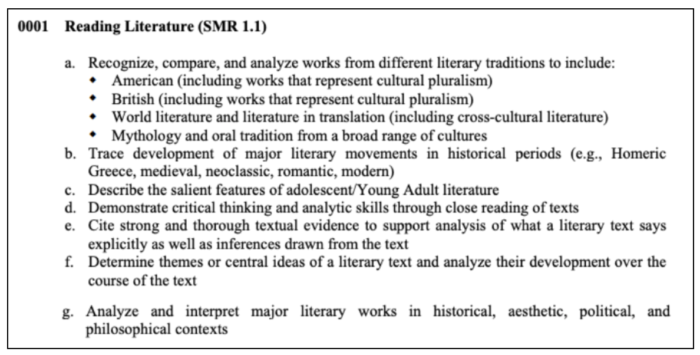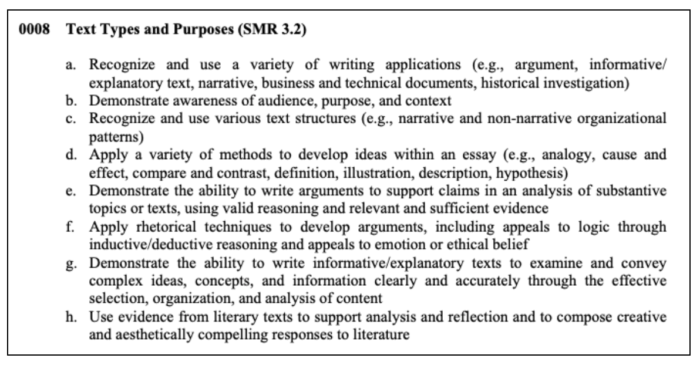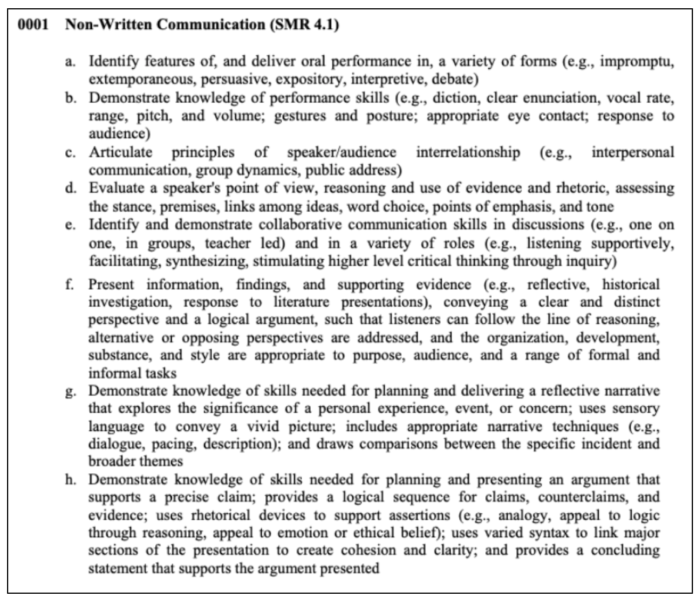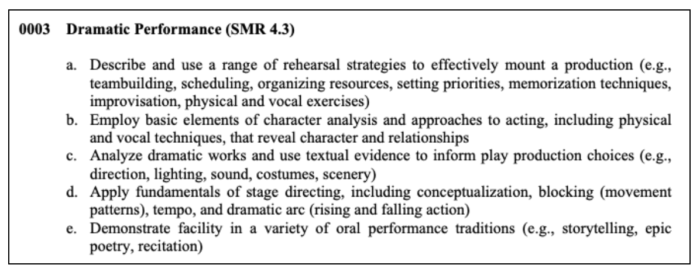Welcome to our CSET English practice test and prep page. On this page, we outline the domains and key concepts for the CSET English exam. It is a free resource we provide so you can see how prepared you are to take the official exam.
While this free guide outlines the competencies and domains found on the exam, our paid CSET English study guide covers EVERY concept you need to know and is set up to ensure your success! Our online CSET English study guide provides test-aligned study material using interactive aids, videos, flash cards, quizzes and practice tests.
Will I pass using this free article? Will I pass using your paid study guide?
If you use this guide and research the key concepts on the CSET English exam on your own, it’s possible you will pass, but why take that chance? With our paid study guide, we guarantee you will pass.
CSET English Test Information
The CSET English is a CBT only exam that is used to test the mastery of specific domains of prospective teachers in grades K-12. The exam consists of 4 subtests that can be taken in one session or individual sessions. If all subtests are taken in one session you have 6 hours to complete all 4 subtests. If taken individually, you have 90 minutes each for subtest I and IV, 1 hour for subtest II and 2 hours to complete subtest III. Subtests I and II consist of multiple-choice questions and subtests III and IV consist of constructed-response questions.

Cost:
The exam fee is $297 if all subtests are taken together. If taken individually, subtest I is $72 and subtests II, III, and IV are $75 each.
Scoring:
Scores are determined by the raw score of each section of multiple-choice and constructed-response questions and based on the weighting of each section. Scores are converted to a range of 100-300.
Pass rate:
The passing rate is determined by each subtest. An individual must score a minimum of 220 per subtest.
Study time:
Make studying a habit in your day to day routine. Devote at least 30 minutes each day to studying. Take advantage of practice tests and use incorrect answers to guide your learning for the next day.
What test takers wish they would’ve known:
- A better understanding of the format of the test
- More specific information on authors and literature
- Glossary terms for each domain
Information and screenshots obtained from CTC.
CSET English Subtest I
Reading Literature and Informational Texts
This domain consists of 40 multiple-choice questions within 6 competencies:
- Reading Literature
- Craft and Structure of Literature
- Reading Informational Texts
- Craft and Structure of Informational Texts
- Integration of Knowledge and Ideas in Informational Texts
- Text Complexity
Reading Literature

This section tests your knowledge of different literary traditions.
Let’s talk about a concept that you will more than likely see on the test.
Features of Young Adult Literature
- Point of view of a protagonist teenager (ex. The Outsiders)
- Dialogue is usually blunt and can be confrontational (ex. Perks of Being a Wallflower)
- Story development is usually over a short period of time (freshman year, summer vacation, spring break)
- Parents are usually absent or have conflicts with the young adults (ex. The Fault in Our Stars)
- Endings are not always happy (ex. A Formal Feeling)
- Coming of age issues (ex. Chocolate War)
Craft and Structure of Literature

This section tests your knowledge of the elements and organization of literature.
Let’s talk about a concept that you will likely see on the test.
Basic Elements of Literature
- Plot refers to the sequential events used to show development in a story. Stories sometimes progress through many different plots. Dramas are divided into acts and scenes. Playwrights use dialogue to develop their plots.
- Setting refers to when and where the story takes place. Settings can be smaller in scale, like a park or forest; or they can be large and encompassing, like an era or historical time period. The characters in the story can also describe the setting and give the reader an interpretation and view of where it is taking place.
- Characters refer to who the story is about. They give readers something in which to invest. Characters can be people, animals, or creatures.
- Point of view refers to who is telling the story. The first person uses words like “I” and “me.” The narrator is part of the story. You only read the thoughts, feelings, and opinions of the person telling the story. The second person uses “you” and is rarely used in fiction. The third person uses words like “he”, “she”, and characters’ names. Third person point of view allows the expression of thoughts, feelings, and opinions of multiple characters.
- The theme refers to the big idea of the story. Examples of common themes include betrayal, loyalty, friendship, love, justice, and hypocrisy.
- Narrative structure refers to the content of the story and the structure that is used to tell the story. The common narrative structure has three parts. It starts with the exposition, or beginning leads into the rising action, climax, and falling action. It ends with the resolution or denouement. However, narratives may take other forms depending on the genre.
- Figurative language refers to figures of speech in the literature that increase effectiveness and impactfulness of the author’s message. Common literary devices include similes, metaphors, personification, oxymorons, hyperbole, and idioms.
- Tone refers to the point of view or attitude the author takes in the story. Tone comes in many forms depending on the author’s feelings. It can be humorous, arrogant, solemn, joyful, sad.
- Diction is word choice. It is an element of drama that advances the plot. Formal, informal, colloquial, and slang diction are used in different contexts and settings in literature. Writers use diction to set a specific mood, tone, or atmosphere for the reader.
- Style refers to how the author chooses words and organization to tell a story. Four main types of writing styles are expository, descriptive, persuasive, and creative writing.
Reading Informational Texts

This section tests your knowledge of the analysis of informational texts.
Let’s talk about a concept that you will likely see on the test.
Summaries of Informational Text
When writing an objective summary of an informational text, you should focus on the central idea and include the title and author of the text. You should provide the most important information and omit supporting or minor details. Do not include any opinions or personal feelings on the information. The information should not be copied but rewritten in your own words. It should not be written in the first person.
Example of an Objective Summary:
Moose
by Christy Mihaly provides important information of a moose’s development. The text explains what regions moose live in and how their bodies are made to adapt to their environments. It explains the changes of their antlers and how they use them to find a mate. The text begins with information on the beginning of a moose’s life and follows it throughout its lifecycle.
Craft and Structure of Informational Texts

This section tests your knowledge of the features and structure of informational texts.
Let’s look at a concept that is likely to pop up on the test.
Text Features
Authors use text features to help the reader navigate through the text easier. Examples include:
- Graphics– visual ways to present information from the text to give the reader a better understanding of the information
- Headers– break the text into sections and make it easier to find information
- Captions– words located directly above, beside, or below a picture that provide specific information
- Table of Contents– outlines important parts of the text and guides the reader to find that information more easily by providing page numbers
- Glossary– usually located in the back of the text and defines bolded words found in the text
- Bold Print– used to show that something is important in the text and can be found in the glossary
Integration of Knowledge and Ideas in Informational Texts

This section tests your knowledge of using different media or formats to evaluate historical documents and use legal reasoning to defend an argument.
Here is a concept that is likely to be part of the test.
The Constitution of the United States
The purpose of the US Constitution is to create a government based on a checks and balances system that protects the rights of its citizens. The major themes of the US Constitution are limited government, checks and balances, separation of powers, popular sovereignty, federalism, and judicial review. The rhetorical features found in the US Constitution are repetition and parallelism.
Text Complexity

This section tests your understanding of the structure and language in a text to determine grade-level appropriateness.
Here is a concept you definitely need to know.
Qualitative Dimensions of Text Complexity
- Levels of meaning can change the complexity of the text. If there is one meaning, like in an informational text, it is easier to understand. If there are hidden meanings, it can make the text more complex.
- Structure can change the complexity of the text. If the plot is in sequential order, it is easier to follow. If there are flashbacks or changes in time, the complexity of the text changes. It becomes harder to follow.
- Language conventionality and clarity refer to the examination of the language in the text. When there are words with multiple meanings, it makes the text more complex.
- Background knowledge demands refer to the level of background knowledge the reader needs in order to understand the text.
Composition and Rhetoric
This domain consists of 10 multiple-choice questions within 5 competencies:
- Writing Processes
- Text Types and Purposes
- Production and Distribution of Writing
- Conventions of Oral and Written Language
- Research to Build and Present Knowledge
Writing Processes

This section tests your knowledge of the structure of the writing process.
Let’s talk about a concept that you will more than likely see on the test.
Revising
Revising is the stage in the writing process where the author revisits their writing to reread and change what they have written. Revising never stops and continues throughout the writing process. It can occur at any time in the writing process. Revising entails many aspects from changing the structure of the writing, rewording sentences, fixing grammatical errors, or even deleting entire paragraphs.
Text Types and Purposes

This section tests your knowledge of the ability to recognize, apply, and demonstrate multiple types of text structures and their purpose of how they contribute to the text.
Here are some concepts you definitely need to know.
Non-Narrative Text Structures
In non-narrative text structures, the text might not be in chronological order but can be organized in a variety of ways. Text structures can be identified by certain signal words that are specific to each structure.
- Problem/Solution has a problem that needs to be solved and lists one or more ways the problem can be solved.
- Cause and Effect tell the reader the result of an event and the reasons it happened.
- Compare/Contrast texts look at the similarities and differences of two or more topics, events, objects, or ideas.
- Description/List is set up like an outline used to elaborate on a specific topic or main idea.
- Time Order/Sequence uses transitional words to structure the events or steps in order.
Production and Distribution of Writing

This section tests your knowledge of ways to use proper writing techniques to produce and share writing products.
Here is a concept that is likely to be part of the test.
Appositives
Appositives rename a noun by using a different noun or noun phrase to redefine it. The purpose of an appositive is to give the sentence more detail and elaborate on the noun being described.
Examples:
My sister’s car, a white sedan, was stolen yesterday.
The appositive is a white sedan and car is the noun it describes.
My mother Jill loves to cook.
The appositive is Jill and mother is the noun it describes.
Conventions of Oral and Written Language

This section tests your knowledge of how to use writing conventions and structures correctly in written English.
Here is a concept you definitely need to know.
Parallel Structure
Parallel structure is where you repeat the same grammatical form within a sentence. It is sometimes referred to as parallelism.
Example:
NOT parallel:
My friend likes to go swimming, hike and take naps.
Parallel:
My friend likes swimming, hiking, and napping.
When the sentence uses parallel structure each verb stays in the same grammatical form of present tense.
Research to Build and Present Knowledge

This section tests your knowledge of demonstrating, gathering, and interpreting research findings to integrate information into written text.
Here are some concepts you definitely need to know.
Footnotes and Endnotes
Footnotes and endnotes are used to cite or give attribution to someone else’s information used in the text. Footnotes are used for a short citation and are located at the bottom of the page it is citing. Endnotes are located at the end of a large section or at the end of the document. Endnotes do not take away from the text on the page and can contain more in-depth information due to their location.
And that is some basic information about Subtest I of the CSET English exam.
CSET English Subtest II
Language, Linguistics, and Literacy
This domain consists of 50 multiple-choice questions within 3 competencies:
- Human Language Structures
- Acquisition and Development of Language and Literacy
- Grammatical Structures of English
So, let’s talk about Human Language Structures first.
Human Language Structures

This section tests your knowledge of the study of language, including phonology, morphology, syntax, semantics, and pragmatics.
Take a look at these concepts.
Morphology
Morphology is the study and analysis of word structures. Words can be broken down into components.
- Inflection is the change of a word by adding a new ending to the base word.Examples: -s, ‘s, -est, -er, -ed, -ing
- The derivation is the formation of creating a new word that is made up by adding a prefix or a suffix to the word. The new word is called a derivative.
- Compounding is taking two complete English base words and combining them to make a new word called a compound word.
- Roots are the base words before anything is added to them.
- Affixes are the most common way to change the meaning or form of a word. A prefix is an affix that is added to the beginning of the word and a suffix is an affix that is added to the end of the word.
Pragmatics
Pragmatics is the study of how words and symbols are used in a communicative context.
- Pragmalinguistics is the formal grammar aspect of understanding language in context.
- Sociopragmatics is the everyday social practices of language.
- Psycholinguistics is how children and non-native learners have to adapt and learn a language.
Acquisition and Development of Language and Literacy

This section tests your knowledge of how to explain, demonstrate, and apply knowledge of how language is acquired.
Take a look at these concepts.
Decoding versus Encoding
Decoding is breaking down words to determine the chunks and individual sounds to be able to read. Decoding is finding patterns and rules in words to segment the word to help read it. Encoding is the opposite. It is blending individual sounds or chunks to build a word to be able to read.
Examples:
Decoding: theme
theme
Breaking the word apart and coding it helps to show that
th makes one sound, the vowel e says its long sound because of the silent e at the end of the VCe word.
Encoding:
s + t + a r + t = start
Each letter or group of letters is individually built upon one another to create the word.
L2 Acquisition
The first language will always have an impact on the acquisition of a second language. Similarities in both languages will have a positive transfer and differences will have a negative transfer on L2 acquisition. For example, when there are similarities in sentence structure it makes a positive transfer because you are able to use L1 knowledge to help L2.
Grammatical Structures of English

This section tests your knowledge of the conventions, structures, and functions of the English language.
Here are some concepts to review for the test.
Verb Complements
Verb complements give added information to the main verb. Verb complements can be noun phrases, adverbs, adjectives, or clauses.
Example:
They asked
him to leave
.
Leave is the verb complement to the main verb asked.
Count and Noncount Nouns
Count nouns are nouns that you can count. It is a count noun if you can make the noun plural or add a number in front of it.
Examples: books, candles, 20 cars, 12 shoes
A noncount noun is a noun that you cannot count or make plural.
Examples: work, air, milk, bread
And that is some basic information information about Subtest II of the CSET English exam.
CSET English Subtest III
CRQ
This domain consists of 2 constructed-response questions: 1 based on literary text and 1 based on non-literary text. These questions require extended responses.
Subtest III covers the same domains and competencies as Subtest I.
For more information on answering constructed-response questions, check out 240 Tutoring’s guide to constructed-response questions.
CSET English Subtest IV
Communications: Speech, Media, and Creative Performance
This domain consists of 4 constructed-response questions within 3 competencies:
- Non-Written Communication
- Media Analysis and Applications
- Dramatic Performance
These questions require short and focused responses.
For more information on answering constructed-response questions, check out
240Tutoring’s guide to constructed-response questions.
So, let’s talk about Non-Written Communication first.
Non-Written Communication

This section tests your knowledge of communication and performance skills needed for presenting oral performances in a variety of forms.
Here are some concepts to review for the test.
Performance Skills
- Dictation is the action of reciting words aloud.
- Clear enunciation is using the correct expression when pronouncing words where they can be heard and understood.
- Vocal rate is how fast or slow you speak.
- Range depends on how much the speaker needs to project to the audience.
- Pitch is measured by the frequency of sound waves and volume is how loud or soft sound is.
- Gestures are the movement of the body and posture is the position of the body.
- Appropriate eye contact should be used when talking to your audience.
- Response to the audience is ongoing. It cues you pick up from your audience’s reaction to your oral performance.
Media Analysis and Applications

This section tests your knowledge of being able to analyze and apply different forms of media.
Take a look at this concept.
Impact of Advertising on Society
One of the positive aspects of advertising is the ability to educate people on events, items, or ideas that they did not know a lot about. Consumers are able to pick and choose what they are interested in and learn more about it. Advertising can also have negative effects on a person to make them feel as if they are not as adequate as someone else because they are not able to go to an event, buy a specific item, or understand an idea. It can also negatively influence children and teenagers by increasing alcohol or tobacco use and by encouraging unhealthy eating habits, sometimes leading to eating disorders.
Dramatic Performance

This section tests your knowledge of describing, analyzing, applying and demonstrating strategies for productions and performances.
Let’s take a look at these concepts that are more than likely to appear on the test.
Fundamentals of Stage Directing
- Conceptualization is the idea or whole picture of what the performance will entail.
- Blocking is where all of the components come together in a scene.
- The tempo is the pacing of the performance.
- Dramatic arc includes rising and falling actions. The rising action is the events that build up to the climax. The falling action is a conflict between the protagonist and the antagonist right before the end.
And that’s some basic info about the CSET English exam.





